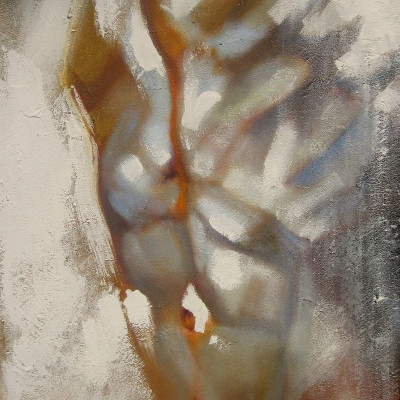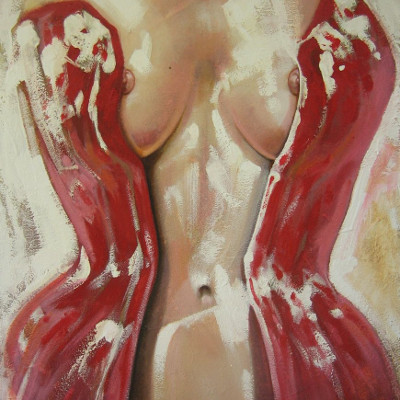Nudi
Grazia Zattarin offers a series of nudes and some landscapes that could be described as dream-like.
It would be a gross simplification if one were to consider the nude in Art as a genre like all the others, such as still lifes, seascapes, portraits, and so on.
In Classical times and later, during the Renaissance, sculptures of nude bodies – mythological gods, heroes, or famous people – were imbued with other values: whoever looked at them could understand their spiritual, symbolic or magic valence. A dilemma. Did, or do, these further dynamics spring only from the work of the artist? Or are they the result of the – more or less unconscious – reactions of the person who is looking at that work of art? This remains an open question that has become increasingly important in the modern age, ever since the invention of photography. However, what seems to be the cultural interpretation of the image today has decayed into iconic stereotypes, into obsessiveness and into a lack of personal emotions. The photographic nude – if one thinks of the works of Helmut Newton – is shown in a series of sequences, without “mysteries”, or resonance, and has become both voyeuristic and theatrical: the result is predictable, constructed eroticism.
THE BARE TRUTHS OF BODIES
Text by critic Michele Petrantoni, Milan 2007 Personal exhibition of paintings
“Seduction … the language of love” “Seduzione…linguaggio d’amore” Hotel Parigi, Bordighera, July 2007
Looking at yourself

Sleeping Mother

Mariposa

At the same time, the erotic nudes drawn by Klimt, could be from another planet, as could the transgressions in Schiele’s paintings or those in certain expressionist paintings - from Grosz to Kirchner. This introduction makes it possible to outline the context in which the work of this artist, Zattarin should be placed. Her nude bodies, mainly women, are shown in all their almost sculptured fullness, but, together, they express the melancholic sensuality of solitude, or of indifference. This could, for example, be said of the paintings “Luce” (Light), Calze Rosse (Red Stockings), or “Viola” where the young woman, covered with a large white veil, is seen from behind. This makes nudity more erotic and triggers a game of seduction between the painter and her public. However, Grazia Zattarin more often adds a type of turmoil when she only depicts partial figures, “hiding” their eyes, or even their entire face.
Memory

Memoria Mixed techniques on canvas, 50 x 70 cm, 2009. Owned by the Galleria Studio, Milan, IT
Sacredness revealed

These images of bodies reveal a type of indistinct eroticism that is not always easy to decode. One could suppose that these young and vibrant bodies draw their realisation from Eros and, together, create a flow of consciousness, with nature. This is just one of the meanings of the paintings dedicated to water – the female, the mother, the eternal recurrence – and the roses could symbolise the transient nature of beauty.
Last but not least, the painter’s material and chromatic experiments reveal a thread of stylistic unity that runs throughout her work: shortened figures and deeply evocative details.
Saturn

Saturno Mixed techniques on canvas, 30 x 40 cm, 2007. Owned by the Galleria Studio, Milan
Viola

Mixed techniques on canvas 80 x 100 cm, 2007. Owned by the Galleria Studio, Milan
The hidden body. Fire

Il corpo occulto. Fuoco - Mixed techniques on canvas, 50 x 70 cm, 2007, (private collection)